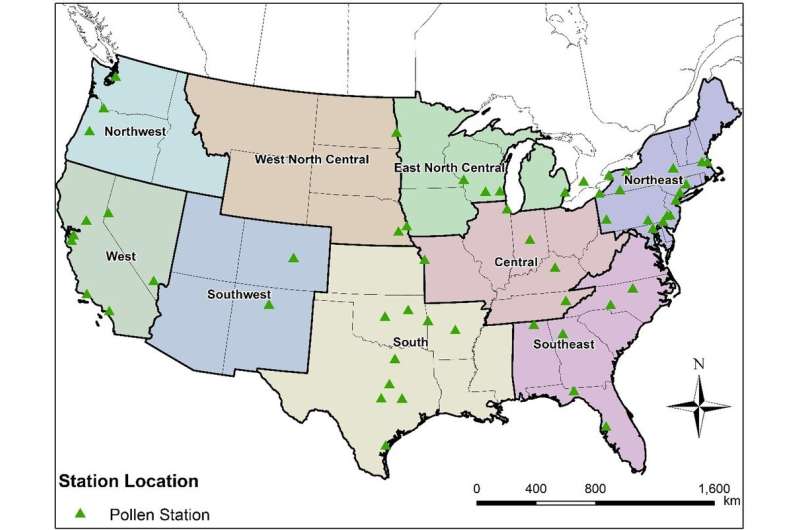Itchy eyes and a runny nose? It could be climate change

Researchers with the Rutgers Environmental and Occupational Health Sciences Institute have simulated how climate change will affect the distribution of two leading allergens—oak and ragweed pollens—across the contiguous United States. The results, published in the journal Frontiers in Allergy, may make your eyes water.
Using computer models, the team, led by Panos Georgopoulos, a professor of Environmental and Occupational Health and Justice at the Rutgers School of Public Health, found that by 2050 climate change significantly will increase airborne pollen loads, with some of the largest surges occurring in areas where pollen is historically uncommon.
"Pollen is an excellent sentinel for the impacts of climate change because shifts in variables like carbon dioxide and temperature affect the way plants behave," said Georgopoulos, who also is director of the Computational Chemodynamics Laboratory at Rutgers and faculty at Robert Wood Johnson Medical School. "At the same time, the production of pollen and pollen's influence on allergic disease has been increasing due to climate change, and this is one of few studies to forecast this trend into the future."
Previous efforts to connect pollen indices with climate change have been limited by a scarcity of data. For instance, there are about 80 pollen sampling stations in the U.S., operated by a variety of private and public agencies using different sampling methods.
To overcome this challenge, the researchers adapted the Community Multiscale Air Quality modeling system, an open-source tool managed by the U.S. Environmental Protection Agency (EPA) to simulate distributions of allergenic oak and ragweed pollen for historical (2004) and future (2047) conditions.
Results showed that even under moderate warming conditions, pollen season will start earlier and last longer throughout the U.S., with increasing average pollen concentrations in most parts of the nation. Mean concentrations of oak pollen could climb by more than 40 percent in the Northeast and Southwest and mean concentrations of ragweed could jump by more than 20 percent in these areas.
Regional pollen shifts were observed, too. In parts of Nevada and northern Texas, oak pollen levels could double by mid-century, while Massachusetts and Virginia could see an 80 percent increase in ragweed pollen by 2050.
The pollen research was part of an ongoing project by the Rutgers Ozone Research Center to study how climate change will influence air quality in the state. The bulk of that work examines the state's struggles with ground level ozone, a byproduct of fossil fuel combustion that can damage the lungs.
"New Jersey's air quality is going to be adversely impacted by climate change, both in terms of anthropogenic pollution and increased levels of pollen," Georgopoulos said. "For people with asthma, exposure to pollen and irritants like ozone increases the odds of respiratory illness. To protect the most vulnerable, we need to understand how these irritants will behave in a warming world."
More information: Xiang Ren et al, Modeling past and future spatiotemporal distributions of airborne allergenic pollen across the contiguous United States, Frontiers in Allergy (2022). DOI: 10.3389/falgy.2022.959594

















